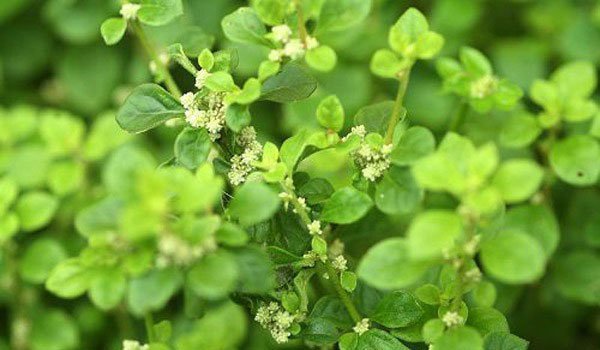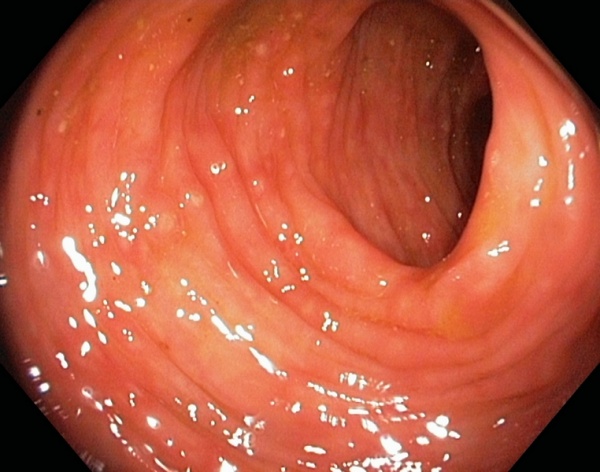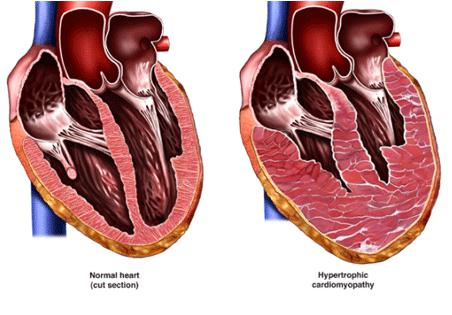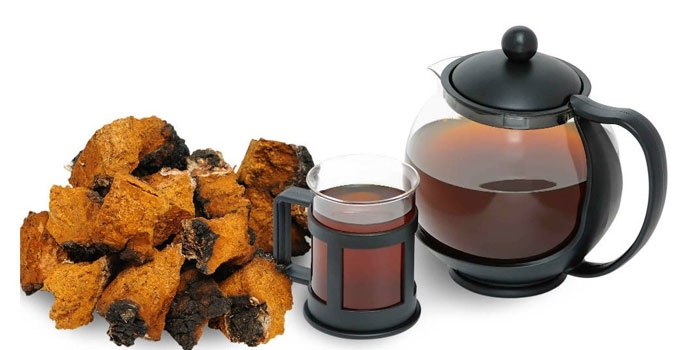Parsley properties and contraindications
Petroselinum crispum Mill.
Curly parsley is one of the oldest cultures, in ancient Greece it was considered a sacred plant, a symbol of glory and joy. Parsley was used to make wreaths for the heroes and winners of the Olympic Games; the horses harnessed to the heroes' chariots were fed this sacred herb.
The birthplace of parsley is the mountainous regions of the Mediterranean, the island of Sardinia, here it grows wild even now. In Europe, parsley began to be bred as a spicy plant from the 15th century, in Russia since the 11th century it has already been grown in gardens and orchards. Now parsley is distributed almost throughout the country, except for the northern regions.
Curly parsley, parsley (Petroselinum crispum Mill., Petroselinum sativum Hoffm) is a widespread, well-known herbaceous plant of the Umbelliferae family, dicotyledonous class.
This is a biennial plant, in the first year it forms a rosette of basal leaves with long petioles and a thickened root. Parsley leaves are twice-, thrice-pinnate bright green, shiny smooth or curly above. Two forms of parsley are known - root and leaf, each form has many varieties.
Root parsley has a white thickened cone-shaped or cylindrical root, leaf parsley has a thin spindle-shaped root.
Parsley blooms in the second year. If you leave part of the roots in the soil for the winter, then in spring in April it appears with the first thawed patches, giving valuable early young greens rich in vitamins. Then in July it blooms, forming a straight, branched stem from the middle, 60-100 cm high.
The inflorescence is a complex umbrella with 10-20 rays at the ends of the branches, crowned with simple umbrellas with yellowish-green or whitish petals. Parsley blooms in June - July, pollinated by various insects.
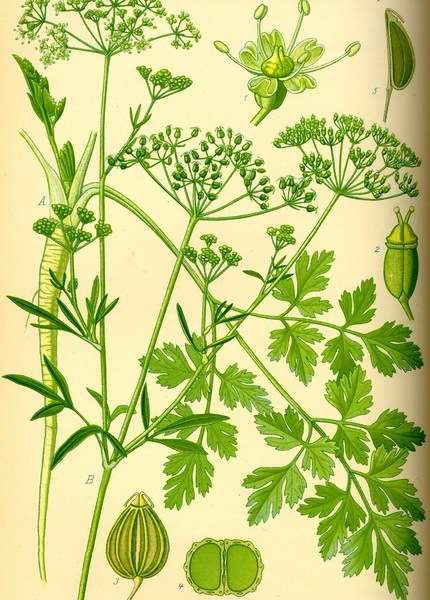
The fruits are grayish-brown oblong ovoid two-seeded seeds up to 3 mm long, ripen in July-August.
All parts of parsley, both tops and roots, have medicinal properties. Therefore, medicinal raw materials are fruits, leaves and roots. Greens are cut, used and harvested all summer. The roots are dug up in autumn in August - September, they must be washed and dried to brittleness. Seeds are harvested as they ripen, dried well.
In folk medicine, parsley preparations are used for edema of cardiac origin, kidney stones, as a sedative and diuretic for inflammatory processes in the bladder, digestive disorders - dyspepsia, flatulence, colic and intestinal spasms, as a diaphoretic at high temperatures, with postpartum bleeding, to regulate menstruation.
Parsley contains many useful substances for the human body. Its medicinal properties are due to the rich chemical composition of all parts of the plant.
Parsley leaves contain up to 0.08% essential oil, ascorbic acid, carotene, luteolin, apigenin, vitamins A, B1, B2, K, PP, folic acid, calcium, magnesium, iron, phosphorus, phytoncides. The roots contain essential oil, mineral salts; fruits, seeds contain essential oil - up to 7%, fatty oil - up to 22%, glycosides, flavonoids.
The healing properties of parsley were highly appreciated by Avicenna, he wrote: "Parsley drives urine and menstruation, it cleanses the kidneys, bladder and uterus." In the medicine of that time, parsley was used as an anti-inflammatory, diuretic, wound healing agent, to preserve vision, to strengthen the gums, for digestive disorders, loss of appetite, and for diseases of the liver and kidneys.
The scientific name of the genus Pertoselinum - from the Greek word petra - "rock", is associated with the place of origin and selinum - the ancient Greeks called celery. The specific name crispum is Latin for "curly" because of the openwork carved leaves. The Russian name of the genus Petrushka is from the scientific name of the genus petra.
Parsley root useful properties and contraindications parsley
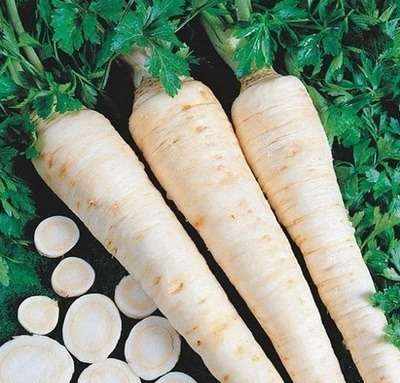
It is useful to use fresh herbs and parsley root in summer in large quantities for edema, kidney and bladder stones, it removes salts from the body, with circulatory congestion, to reduce sweating.
In folk medicine, parsley preparations are used for urolithiasis, dropsy, cystitis, prostate inflammation, uterine bleeding, liver diseases with indigestion, dyspepsia, flatulence, and neurosis.
Parsley has a lot of potassium, so it must be used in the diet of patients with kidney and cardiovascular diseases. Extracts from the leaves and roots improve breathing and cardiac activity. Parsley preparations improve the functioning of the digestive system, regulate menstruation.
Parsley seeds useful properties and contraindications
Seeds and essential oil from parsley seeds are used in medicine as a diuretic and antispasmodic, stimulating the secretion of the gastric glands, which helps to increase appetite and improve digestion.
Seeds are used for painful menstruation, cycle disorders, inflammation of the prostate gland.
Crushed seeds are rubbed into the scalp for baldness. Ointment with parsley seeds or with a thick decoction of seeds has an insecticidal effect, it is used for pediculosis.
With inflammation, kidney and bladder stones, edema:
- Decoction of seeds: Pour one teaspoon of seeds with 2 cups of boiling water, boil for 5-7 minutes, strain after cooling. Drink 1/4 cup 5 times a day.
- Parsley decoction: 2 tbsp. l. chopped raw materials (root with herbs) pour 2 cups of boiling water, boil for 10 minutes or brew in a thermos for 2 hours, then strain. Drink small amounts throughout the day.
For diseases of the joints, arthritis:
Infusion: one tbsp. l. chopped dry parsley (greens and root), pour 2 cups of hot boiled water, leave for 8 hours, strain. Take 2 - 3 tbsp. l. 3 - 4 times a day before meals for 10 days.
For inflammatory eye diseases:
Mix parsley and carrot juice in a ratio of 1: 3. Drink half a glass of juice 2 times a day.
With urolithiasis:
- One tsp finely chop the leaves and roots of fresh parsley, pour 1 cup of boiling water, leave for 2 hours (or in a thermos). Take 1/3 cup 3 times a day one hour before meals.
- One st. l. chopped parsley roots pour 1 cup boiling water, leave for 2 hours, strain. Take 1/4 cup 4 times a day 20 minutes before meals.
- Three Art. l. Pour seeds with 1 glass of water, boil for 10 minutes, strain after cooling. Take 1 - 2 tbsp. l. 5 times a day.
For gallstone disease:
0.5 - 1 g powder from the leaves or seeds of parsley take 2 - 3 times a day before meals.
For edema caused by heart failure:
One tsp parsley seed powder pour 1 cup of chilled boiled water, cover, leave for 8 hours, strain. Take 2 tbsp. l. 4 times a day. The drug is a diuretic, anti-inflammatory.
With painful menstruation, cycle disorders, with inflammation of the prostate gland:
- 4 tbsp. l. crushed seeds pour 1 cup boiling water, boil for 15 minutes, cool, strain. Drink 1 tbsp. l. 4 - 6 times a day.
- 1 tsp seed powder pour 1 cup of cold boiled water, cover, leave for 8 hours, strain. Drink 1/4 cup 4 times a day before meals.
For prostatitis:

- Squeeze juice from parsley. Take 1 - 2 tsp. juice 3 times a day 30 minutes before meals for 20 days. take a break for 10 days, then repeat the course of treatment. When treating, it is recommended to use onions, garlic, honey up to 3 tsp. in a day.
- 4 tsp crushed roots pour 1 cup boiling water, leave for 15 minutes, strain. Take 1 tbsp. l. 3 times a day 30 minutes before meals.
- 0.5 tsp seed powder pour 1 cup boiling water, leave for 8 hours, strain. All drink 1 tbsp. l. during the day.
Parsley root use in medicinal preparations
For gout, rheumatoid arthritis:
- Elder flowers - 3 parts
- nettle leaves - 3
- parsley root - 3
- willow bark - 1
Pour one tablespoon of the collection with a glass of boiling water, boil for 5 minutes, leave for 20 minutes. Take warm 1/2 - 3/4 cup 2 - 3 times a day 30 minutes after meals.
- Birch leaves - 1 part
- nettle leaves - 1
- violet grass - 1
- parsley root - 1
One st. l. mixture pour a glass of boiling water, boil for 10 minutes, leave for 20 minutes. Drink warm 1/2 - 3/4 cup 3 - 4 times a day for gout, rheumatoid arthritis.
With urolithiasis:
- Birch leaves - 1 part
- lingonberry leaves - 1
- Juniper fruits - 1
- celandine grass - 1
- parsley root - 1
- nettle leaves - 1
- fennel fruits - 1
One st. l. collection pour a glass of boiling water, boil for 10 minutes, leave for 2 hours. Take 1/3 - 1/2 cup 2 - 3 times a day 20 minutes before meals.
Essential oils and phytoncides contained in parsley have a strong bactericidal effect. Parsley preparations increase the tone of the smooth muscles of the uterus, intestines, bladder.
Fresh juice from greens and parsley roots is used as an anesthetic and anti-inflammatory agent externally in the treatment of dermatitis, with the bites of bees, wasps, mosquitoes; fresh juice protects against insect bites.
Chew on fresh or dry herbs or parsley root to eliminate the unpleasant odor from onions or garlic.
Parsley contraindications:
- Seeds, parsley root and decoctions of them are contraindicated during pregnancy. Parsley preparations tone the uterus, their use can lead to miscarriage.
- Parsley preparations are contraindicated in diseases of the pancreas, with pancreatitis.
- Preparations from the root are contraindicated in nephritis.
Parsley medicinal properties in cosmetology

In cosmetics, parsley has long been used as a skin whitening agent.
To whiten the face after a strong tan, wash the face with a decoction of parsley roots.
To whiten the face, lubricate the face daily with the juice of fresh leaves.
To remove freckles and age spots:
- Wipe the face in the morning and evening with a strong decoction of parsley root mixed with lemon juice.
- With a mixture of parsley root juice and lemon juice in a ratio of 1: 1, lubricate the face at night.
- It is useful to wash with infusion of parsley leaves: one tbsp. l. finely chopped leaves pour 0.5 liters of water at room temperature per day. This infusion is good to wipe the face with redness of the skin.
- Prepare a mask or compress for skin whitening from parsley and yogurt.
Milk-herbal infusion for facial skin:
Chop the leaves of parsley, sorrel, tarragon, rosemary, insist in milk for 2-4 hours. Wipe the face with milk infusion. The skin becomes fresh, smooth, elastic. Suitable for any facial skin.
For hair loss:
- Rub the powdered parsley seeds into the scalp. Rinse your hair with warm water after 30 minutes.
- Rub parsley juice into the scalp.
For hair loss, dandruff, itchy skin:
- Seed powder - 1 tsp
- alcohol - 1 tsp
- castor oil - 2 tsp
Mix everything thoroughly, rub the mixture into the scalp every other day. Course 15 procedures. A month later, the course can be repeated.
For swelling of the eyelids:
- Grind fresh parsley leaves, put in gauze, put on the eyelids, hold for 15 - 20 minutes. Then wash with cool water.
- Finely grate fresh parsley root, put in a piece of bandage or gauze, put gruel on the eyelids, rinse with warm water after 20 minutes.
To add shine to dull hair, it is useful to rinse washed hair with parsley decoction.
I suggest watching a video about the correct sowing of parsley, choosing a place:
How to sow parsley in spring at the end of April
Parsley leaves and root use in cooking
Parsley is very fragrant due to its high content of essential oils, it is widely cultivated as a spice. It has a high content of vitamin C - a small bunch of fresh parsley provides the body's daily need for ascorbic acid and carotene.
Parsley leaves and root are used both fresh and dried. Greens are used in cooking as a seasoning and garnish, it is added to salads, first and second courses. It fortifies, flavors food, improves the appearance of dishes.
Aromatic sweet root is put in soups, broths, it is used in the preparation of vegetable, meat, fish dishes, for the preparation of special sauces for these dishes. Parsley is used in home canning, in the canning industry.
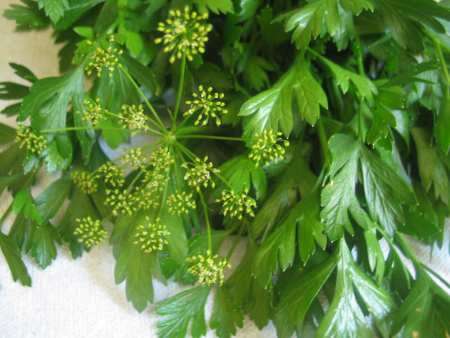
It is useful to prepare parsley as a medicinal herb and for culinary purposes for the winter. It can be frozen, dried, salted and used in winter.
Dear readers! I hope you found the article useful Parsley medicinal properties and contraindications Parsley root application and you learned something new about the beneficial properties and contraindications of parsley and its use for medicinal purposes, as well as in our daily lives.
Look at the photo from in the Aptekarsky garden of Moscow State University
Use the healing powers of the natural world and be always healthy!
- Intercostal neuralgia - what is it and how to treat
- How to quickly get rid of dry corns on the legs
- How to treat left ventricular hypertrophy
- Rating of the best drugs for rotavirus for children
- Making tea from currant leaves, the benefits and harms of the drink
- How to drink hydrogen peroxide according to Neumyvakin - an oral regimen
- Features of the treatment of plantar fasciitis with folk remedies
- The composition and beneficial properties of parsley root
- How to get pregnant quickly? Folk remedies
- Herbs-ants in the "pot-bellied" period or the use of herbal medicine during pregnancy
- Why does a sore throat and dry cough occur, and what treatment is required?
- Guy's Room Design: Ideas and Examples
- General rules for drawing up a foundation plan House foundation drawings
- modern art deco bedroom small art deco bedroom
- Pansies: characteristics and photos of flowers
- Making an art deco bedroom: the choice of materials Beige art deco bedroom
- Bedroom interiors in art deco style Bedroom art deco style beige
- Young: planting and care in the open field Young planting and care in the open
- Varieties for open ground
- Pansies: cultivation and care in the open field




